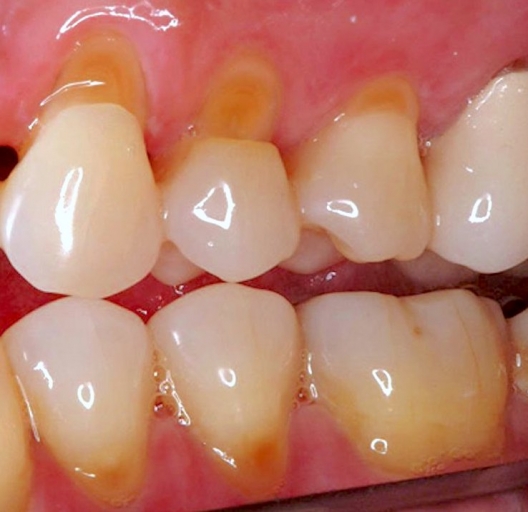Whiter Teeth at What Cost? Potential Erosive Effects of Whitening Products
By Imahn Moin on December 13, 2017 |I remember attending the Worn Dentition seminar last year and Frank citing an article that highlighted the finding that most non-carious cervical lesions (NCCLs) could not be recreated strictly with occlusal loading; only in conjunction with acid exposure were these lesions noted.1
Studies have also shown that after an acidic attack, teeth are more susceptible to toothbrush abrasion. 2 This helped me realize that these NCCLs we routinely see likely don’t have a single cause, but are often multi-factorial and likely hinge on an exposure to an acidic environment.

Critical pH of dental enamel
Some studies have indicated that the critical pH of dental enamel is 5.5. The critical pH refers to the pH at which a substance, in this case the hydroxyapatite of enamel, begins to dissolve. 3 With less mineral content, the critical pH of dentin is generally thought to be slightly more resistant to acidic exposure (but has a lower hardness value and more susceptible to abrasive forces).
It’s also important to keep in mind that these critical pH values are not set in stone, and vary depending on the oral environment and the relative presence of calcium and phosphate ions in the saliva. 4 The critical pH may rise to as high as 6.5 in individuals with low salivary concentrations of calcium and phosphate and as low as 5.5 in those with high salivary calcium and phosphate concentrations, making it more resistant to erosion. 5
pH of dental whitening products
We all know to warn our patients of some of the most acidic foods and beverages that they are likely to consume, such as soda, citruses and tomato juice. But with the widespread rise in popularity of teeth whitening procedures and products, we also need to keep in mind that some dental products are more acidic than we would like, especially when some whitening systems recommend daytime use for up to an hour, and some nighttime applications may be on the tooth for 8 hours or more.
Two studies looked to measure the pH of four subgroups of dental whitening products:
- Dentist-supervised home bleaching (DSHB) products (i.e. custom trays with supplied gels)
- In-office bleaching (IOB)
- Over-the-counter (OTC) bleaching products
- Whitening toothpastes

The tables of all their results, and the products they tested, can be found in the associated studies. I’ll focus on summarizing the number of samples found below a pH of 6. Amongst the samples tested between the two studies, there were four DSHB products with a mean pH below 6 (low of 4.88), four IOB products (low of 3.6), five OTC products (low of 3.76), and one toothpaste (4.22).
Keep in mind that as mentioned earlier, the critical pH for some people may be as high as 6.5, and some of the most acidic substances, with a pH below 4, were directed to be applied for 30 minutes or longer. It wasn’t all doom and gloom however, with many options having a pH of 7 or above. 6, 7
I don’t know about you, but anytime I use a whitening system, whether it’s been with a custom tray and bleaching gel or an OTC product like whitening strips, my first tendency after I finish is to brush my teeth to get rid of the terrible taste. Most of us have heard that you shouldn’t brush your teeth immediately after drinking sugary or acidic beverages such as soda or citrus juices; it can take up to 15 minutes for our saliva to clear the beverage and to buffer the pH back to neutral. 8 Up until that time, the enamel may be considered soft, and especially prone to toothbrush attrition.
In light of these studies, I would recommend advising your patients to be careful about brushing immediately after their whitening session, rinsing with water to help aid in clearance of the product and help aid them in choosing a product with a more neutral pH.
References
1. Grippo JO, Chaiyabutr Y, Jois JC. Effects of Cyclic Fatigue Stress-Biocorrosion on Noncarious Cervical Lesions. Journal of Esthetic and Restorative Dentistry. 2013:25(4):265-272.
2. Voronets J, Lussi A. Thickness of softened human enamel removed by toothbrush abrasion: an in vitro study. Clin Oral Investig. 2010L 14(3):251-256
3. Barron RP, Carmichael RP, Marcon MA, Sàndor GK. Dental erosion in gastroesophageal reflux disease. J Can Dent Assoc 2003; 69(2):84–9.
4. Dawes C. What is the Critical pH and Why Does a Tooth Dissolve in Acid? J Can Dent Assoc. 2003:69(11):722-724
5. Ericsson Y. Enamel-apatite solubility. Investigations into the calcium phosphate equilibrium between enamel and saliva and its relation to dental caries. Acta Odont Scand 1949; 8(Suppl 3):1–139.
6. Majeed A, Grobler SR, Moola MH. The pH of various tooth-whitening products on the South African market. SADJ. 2011:66(6):278-281
7. Price R, Sedarous M, Hiltz G. The pH of Tooth-Whitening Prodcuts. J Can Dent Assoc. 2000:66:421-426.
8. Rinki Hans, Susan Thomas, Bharat Garla, Rushabh J. Dagli, and Manoj Kumar Hans, “Effect of Various Sugary Beverages on Salivary pH, Flow Rate, and Oral Clearance Rate amongst Adults,” Scientifica, vol. 2016, Article ID 5027283, 6 pages, 2016.
Dr. Imahn Moin, DDS. http://www.oaktreedentalcare.com/